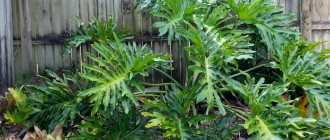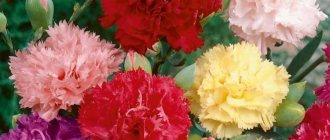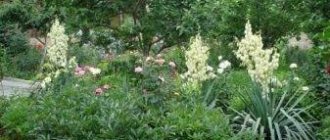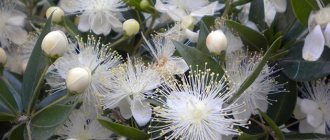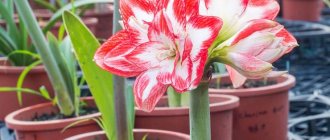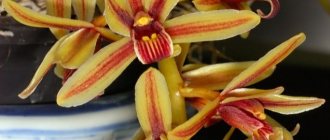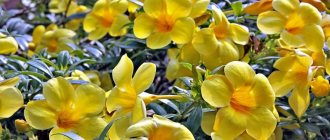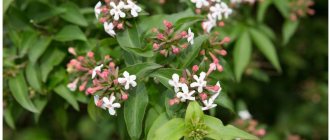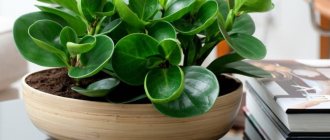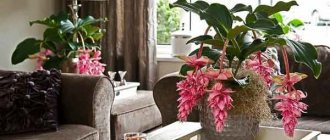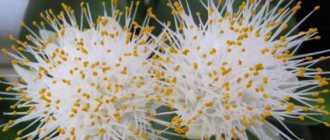Philodendron is an evergreen plant native to tropical regions of the world. This vine can be found in the jungles of Latin America and Australia.
The name has ancient Greek roots and literally translates as “tree-loving,” which indicates the peculiarity of the existence of philodendron in the wild: for normal growth and constant access to sunlight, it uses tree trunks as support.
There are many types of this vine, some of them are cultivated in botanical gardens and greenhouses, but philodendron is also popular as a houseplant due to its decorative appearance. This is an unpretentious flower that even a novice gardener can grow.
History of Philodendron
In the period from 1932 to 1935 There was a bloody war between Bolivia and Paraguay. Covering the chronicles of these military events, journalists from all countries wrote about cannibal plants. So in their articles, reporters wrote that the remains of soldiers are regularly found under the same tree. Their bodies are drained of blood and covered with huge leaves.
The journalists' version said that in South America there is a certain tree whose flowers exude a hypnotic aroma that attracts people. People, intoxicated by the smell of the plant, go to it in fascination. Then the plant grabs the person and tightly entwines it with its foliage, with the help of which it sucks all the blood from its prey.
This scary monster from the jungle turned out to be Philodendron.
The reporters' tales of course attracted attention from the scientific world. However, research has completely refuted them.
Philodendrons form huge shady thickets in nature, close to a water source. Their flowers smell really nice to attract insects for pollination. But they have neither a poisonous nor a narcotic effect on people. And of course they do not feed on human blood.
And the wounded soldiers simply tried to hide from their enemies in the shade and coolness of the philodendron, dying from blood loss caused by numerous wounds.
However, this is not the first and not the last mention of Philodendron.
This plant has attracted the attention of the ancient peoples of South America for centuries; modern scientists never cease to study and experiment with the mysterious flower. It was loved by both florists and home gardeners for its variety of species and decorative foliage.
Name and its origin
The liana Philodendron erubescens (lat.) received its name due to the red color of the leaves, stems and petioles. As the plant develops and matures, the foliage acquires green shades, but the petioles still remain red.
According to the classification, philodendron belongs to the perennial evergreen vines of the Araceae family, which naturally grow in the tropical forests of Brazil, Colombia and Costa Rica, as well as Australia. This family has about 900 species (data from researchers at the Missouri Botanical Garden).
This species was first described in 1854. The literal translation of the name means “tree-lover,” which characterizes the habit of this plant to cling to tree trunks with its flexible, twisting stem in order to make its way upward to sunlight.
Description of the plant
Philodendron is a member of the Araceae family. The name comes from two Greek words “φιλέω” - “love” and “δένδρον” - “tree”.
There are almost a thousand varieties of Philodendrons in nature.
It is an evergreen, flowering, perennial herbaceous plant native to the tropical forests of South America. From this continent, Philodendron spread throughout the planet and can now be found even in the rainforests of Australia and New Zealand. Philodendrons have life forms of hemi-epiphytes, epiphytes, semi-epiphytes, subshrubs, terrestrials and lianas.
Philodendrons dominate other tropical plants. They can be found along roads, various fresh water bodies, on rocks and plains. They climb other plants and spread along the ground, occupying significant spaces. These are werewolf plants. They can adapt to any natural landscape and conditions, changing life forms - transforming from a terrestrial plant into an epiphyte, releasing aerial sucker roots.
Philodendron White Knight
A mystery that scientists cannot solve to this day is the foliage of Philodendron. The plant, for some unknown reason, produces two types of leaves at the same time. Some leaves are scaly with a bud from which new shoots grow. And others are ordinary ones on a petiole. Flowers grow from leaves with a petiole. At the same time, some leaves, regardless of their type, remain with the plant until the end of its life, while others are regularly shed by the philodendron. Scaly and regular leaves alternate with each other.
In gardening, Philodendron has taken root precisely because of the diversity and beauty of ordinary leaves. They are presented in the form of arrows, ellipses, and hearts. Leaf blades are dissected, pinnate and whole. At the same time, as the plant develops and ages, the leaves transform from arrows into hearts.
Not only the shape, but also the color of the foliage is in a process of constant change. Changes in color are caused by any external influences and the age of the plant. However, there is one general tendency - the outer part of the leaf always has a darker shade than the inner one.
Such endless changes within one species over the course of two hundred centuries made it impossible for botanists to correctly describe this amazing group of plants.
Philodendron flowers have the shape of a spadix, covered with a petal-veil. The color of the petal is two-tone - white light green or red turning into burgundy. The flowers have a persistent sweetish aroma. The flowers produce large, fleshy berries. The fruits are edible and taste similar to bananas.
In addition to edible fruits, Philodendrons have other beneficial properties that are used in human life. Thus, ropes are made from aerial roots, and baskets are made from bark. The latex of some Philodendron species is an antiseptic and is used in medicine.
In addition, the juice of the plant is used as glue. The dye used to make red paints is extracted from the flower bedspread. Philodendron juice was also part of the curare poison. Currently, such juice is part of a poisonous mixture for stunning fish.
In turn, philodendron juices are not poisonous; intoxicating substances are produced in them only during the fermentation process.
Philodendron leaves perfectly filter the air from pollution, and also predict the weather - a day before the rain begins, the plant is covered with dew drops.
Burle Marx varieties: description and photos
Philodendron Burle Marx attracts professional designers and amateur flower growers with its exquisite decorativeness. Depending on the plant variety, its leaf blades have different shapes and bright, sometimes multicolored colors.
Green
This variety of indoor flower forms a lush crown of oblong oval leaves with a sharp tip, growing on long petioles.
The emerald-colored rosette looks lush and seems to shine with a bright gloss.
Variegated
The most attractive variety of this species forms a dense, spherical crown.
Large, slightly corrugated leaf plates from which the rosette is formed are painted in several colors: dark green, light green and white.
Fantasy
This variety has very large leaf blades that resemble the shape of a blade. Long petioles deviate greatly from the central trunk.
The stems and the back of the leaves with large veins have a reddish tint. And the front surface is covered with small grooves and a fine mosaic pattern.
Albo Variegata
The rarest variety of Philodendron is Burle Marx.
It is distinguished by a variegated crown, painted in a variety of shades: cream, yellow, green, bicolor or striped with pink spots. A mature plant can cost over $300.
Decorative types, names with photos
Philodendron verrucosum
The regular leaves are heart-shaped and have a velvety texture. The length of the leaf plate is 20 centimeters and the width is 10. The color is dark green, with shining bronze veins. The cover of the flower is pale yellow.
Philodendron Erubescens
The shoots of the plant can reach a length of up to two meters. Therefore, this species is suitable as an ampelous plant. The leaves are oval-shaped, 30 centimeters long and 25 centimeters wide. The color of the upper part of the leaf blade is green, and the lower part is red.
Philodendron Scandens
An ampelous plant with medium-sized heart-shaped leaves (15cm×10cm). The color is green, monochromatic, glossy.
Philodendron Atom / Philodendron Atom
Decorative, low-growing bush. Short stems produce petiolate leaves 30 centimeters long. The sheet is cut into five parts, the edges of each forming bends in the form of waves. The foliage color is green, with a glossy tint.
Philodendron Ivy / Philodendron Hederaceum
This species is represented by a vine whose shoots stretch up to six meters. Regular leaves are heart-shaped, thirty centimeters long. Their color is dark green. The flowers are very showy - pale red ears in a light green petal cover.
Philodendron Sello or Bipinnate Philodendron / Philodendron Bipinnatifidum
This species has the ability to transform. The maximum size of the stems, covered with dense bark, reaches three meters. The petiolate leaves are triangle shaped and khaki colored and consist of two parts. However, triangles can take on the shape of hearts and also change color to green.
Philodendron Panduriforme
The stems of this vine climb up the supports. Their maximum length does not exceed two meters. Young petiolate leaves have an elongated heart-shaped shape. With age, the center of the leaf blade “thinner” and takes on the shape of a guitar. The foliage color is stable - bright green.
Philodendron Laciniatum
The lobed philodendron is also a vine whose leaves are capable of changing. Ideally oval leaf plates turn into three-fingered, and subsequently five-fingered. The foliage color is green.
Philodendron Evans / Philodendron Evansii
This species is attractive due to the size of its petiolate leaves. The leaf blades grow up to a meter in length and up to 50 centimeters in width. These leaves change shape from triangles to hearts. The edges of the plate form a wave. The color of the foliage is also changeable and young specimens have a bronze cast, against which green veins appear as clear lines. Mature leaves become a solid green.
Philodendron Radiatum
Due to its rapid growth, this vine is valued by landscape designers and is perfect for landscaping parks, arches, garden plots and interior walls. The length of the shoots reaches three meters. The main leaves are small, dissected-oval, green.
Philodendron Elegans / Philodendron Elegans
Both the foliage and the flower are valued in this species. The plant has one shoot, which becomes woody with age. Petioled leaves almost a meter long grow on this shoot. They have a deep cross section and a rich dark green color. The flower consists of a spadix covered with a matte pale green petal spathe, the edges of which are framed by a pink stripe.
Philodendron Xanadu / Philodendron Xanadu
Also a vine with half-meter foliage. The leaf blade is soft, airy and feathery. Color: emerald.
Philodendron: is the plant suitable for the home?
Philodendron is one of the most popular indoor plants. The shape of leaves of different varieties and other appearance features provide high decorative potential. Many varieties, such as radiant or brilliant, are compact.
The largest species, those that have large leaves more than 50 centimeters in length (philodendron bipinnate) or those that grow high (more than a meter), are usually grown in greenhouses and botanical gardens.
However, if there are conditions at home for the growth of these plants, even they can become a beautiful decorative solution.
Home care
Lighting
To grow philodendrons, you need well-lit places, but the light should be diffused. If there is insufficient lighting, the plant will begin to change the shape and color of the foliage.
Temperature
Philodendrons prefer stable temperatures between 18-25 degrees. Without fluctuations and drafts.
Watering and humidity
Philodendrons should only be watered with filtered, settled water at room temperature. The soil in the pot should be constantly moist, but not wet. After abundant watering, all excess water is immediately drained from the pan.
Moist air is vital for philodendrons. Therefore, the place where the pot with the plant stands needs to be equipped with humidifiers, spray water over the crown every day, wipe the leaves with a damp sponge and even bathe in the shower.
Because of their love for moisture, Philodendrons are often used for landscaping and decorating bathrooms and saunas.
Philodendron Sello
Priming
Philodendrons require light soil with neutral acidity. For the substrate mixture, you can use sand, peat, perlite, crushed coniferous bark, turf or leaf, as well as ordinary garden soil, in equal proportions.
To prevent root rot, it is important to fill the bottom of the pot with expanded clay or broken brick for drainage, and add charcoal or dried moss to the substrate.
Fertilizers
In the cold months (October - April), mixtures of mineral fertilizers must be added to the soil once every 30 days. And in the warm season (May - September) the plant needs organic substances.
At the same time, philodendrons cannot tolerate nitrogen, and fertilizing containing this element should be avoided. Due to excess nitrogen, the foliage of the plant will lose its decorative color.
Trimming
Philodendron stems grow very intensively. They should be trimmed as they grow to maintain their size and decorative shape. The cut areas should be treated with activated carbon powder.
Transfer
The earthen part of the philodendron root system is very compact and its growth is almost invisible. The plant prefers a compact pot. You should not disturb the philodendron with frequent transplants and carry out such manipulations more often than once every 3-5 years.
Landing
Choosing a pot
The size of the container should be slightly larger than the root system of the flower (radius about 10-12 cm). There must be a drainage hole and drainage.
A support corresponding to the length of the vine is installed in the center of the pot (the support should not be completely smooth).
The soil
The best option is fertile light soil for decorative deciduous crops. It is possible to use a universal soil mixture for potted plants. Scandens Micans can be grown using hydroponics.
Landing rules
The favorable period is the beginning or middle of spring.
- Drainage is placed at the bottom of the pot, soil is poured on top.
- The roots of the plant are completely covered with soil (they do not cover the growing point).
- Water the plant abundantly.
Air layering:
- pre-moisten the soil;
- layering in the soil, fixed with wire or pins;
With a cutting or a leaf with a “heel”:
Planting material is placed in cold water. After the roots appear, they are planted in the soil.
- placed in moist soil;
- create greenhouse conditions - cover with a cut-off plastic bottle with an open neck;
- after 2-3 weeks they are planted in separate permanent pots.
Philodendron propagation methods
Seeds
It is not possible to propagate all types of Philodendrons from seeds at home. Plants have a very complex mechanism of pollination, fertilization and germination. Therefore, this method is only possible in nature, or in high-tech greenhouses.
Cuttings
The shoots or leaves remaining from pruning are used as planting material for propagating philodendrons at home.
For cuttings, twigs with several internodes or petioles from leaves with a whole bud are suitable.
The cuttings are laid horizontally in a damp mixture of sand and peat, and placed under film or glass. The petioles begin to take root within a month, after which they can be picked up and placed in separate containers.
Horizontal layering
The bark on one of the side shoots is cut with a sharp, sterilized blade. The cut site is wrapped with sphagnum. The moss is moistened with a spray bottle several times a day. After a month, roots will sprout on the shoot, then the shoot is cut off and planted in a substrate for philodendrons as an independent plant.
Cost, where to buy
You can purchase spectacular culture in specialized and online stores. In addition, it is possible to buy a plant or exchange it for another on the forums of amateur gardeners.
The price of a one-year-old specimen is about 400-500 rubles, and an adult (large) one reaches several thousand rubles.
Attention! Most companies specializing in the sale of indoor flowers via the Internet deliver goods to all parts of our country. The goods can be paid for by bank transfer or, after receiving the parcel, by cash on delivery.
Diseases, problems, pests and treatment
Philodendrons are not susceptible to any of the types of diseases characteristic of house plants.
The only problem can be rotting of the earthen root, which begins due to overflow and stagnation of water in the pot. If you exclude the swamp factor, the philodendron will heal itself. But you can help the plant heal faster if you remove parts of the root damaged by rot.
Very rarely, mainly from neighboring plants, thrips, scale insects, spider mites or mealybugs can get on the philodendron. Getting rid of them won't be difficult. One treatment with insecticides or a simple shower is enough.
Conditions for growing indoor philodendrons
Feeling great at room temperatures, blushing philodendrons adapt to light much better than one would expect from such giants. It’s easy to choose conditions for it - but only if you provide the plant with enough free space.
Philodendron blushing is an excellent candidate for novice gardeners who want to start a large, showy, but still fairly simple plant.
Philodendron blushing belongs to poisonous plants; contact with the juice of any parts causes severe skin irritation. But at the same time, it is one of the most effective phytofilters, absorbing toxins from the air and effectively healing the plant environment.
Lighting and placement
Bright but soft light is ideal for blushing philodendron. This large plant is placed on window sills only when it is young, because its size will not allow the vine to fit into a limited space. But even not far from the window, the bushes are developing and look absolutely normal.
A place that is too bright or exposed to direct sun has a negative impact on the colors of the plant: light shading and diffuse mode show red tints much stronger than bright light.
With slow training at a young age, blushing philodendrons grow well in fairly dense partial shade. Lighting is of particular importance at the flowering stage, when it should be quite intense. But since blushing philodendron blooms rarely, more careful control of lighting is almost never required.
Varietal philodendrons, as a rule, are no more light-loving than the base plant. The exception is varieties in which the leaves themselves are colored red. Cultivars such as 'Burgundy' prefer bright, indirect light.
The optimal place for this type of philodendron is considered to be a distance of about 1 m from the southern and partially southern windows and placing them close to the windowsill near the eastern and western ones. On the north window, reddening philodendron can remain only in summer and only on the windowsill.
The main difficulties with growing philodendrons are related to finding a sufficiently spacious room for it. This is truly a giant, and growing quickly. Like any vines, the blushing philodendron will require support, and the mass of shoots and the complexity of formation require choosing the most reliable options.
But still, the search for free space is much more important than the quality of support. This vine does not tolerate cramping and in small rooms it suppresses the surrounding environment, conceals the entire space, so it should be displayed in the most spacious rooms in the house. Only in the first years of cultivation do philodendrons feel comfortable in small rooms.
Philodendron blushes grows well in complex compositions. In winter gardens, greenhouses, and on green screens, it can be mixed with other vines and planted in common containers.
Temperature and ventilation
This plant does amazingly well in room temperatures. He is comfortable in the same place as his owners. If it is impossible to lower temperatures in the winter, the reddened philodendron can overwinter in ordinary living rooms.
This is a heat-loving species, the minimum permissible values for which are about 12 degrees (to preserve decorativeness - 16 degrees). Usually, cold immediately leads to partial loss of leaves, so in winter, if there is a risk of overcooling of the substrate, it is better to leave the red philodendron in warmer rooms. The temperature of the soil in pots is much more important than the air temperature.
Philodendron blushing cannot stand heat. Any temperature above 25 degrees leads to partial drying of the edges of the leaves. When temperatures rise, it is better to take measures to increase air humidity. Spraying the leaves is the most effective way.
Philodendron blushing is an excellent candidate for beginning gardeners. © rubus-idaeus
Difficulties in care
- The tips of the leaves darken and dry out - the humidity in the room is too low, insufficient watering, or the presence of drafts.
- Leaves wrinkle - insufficient watering or humidity.
- The leaves are elastic, but the tips darken - excessive watering, waterlogging of the earthen clod.
- Brown spots on the surface of the leaf plate are burns from direct sunlight.
- Leaves darken - kept at too low temperatures.
- The leaves are pale in color and become smaller - insufficient daylight.
- Pale leaves (not necessarily the presence of brown spots) - an excess of sunlight.
- The leaf plate curls down - the soil is oversaturated with fertilizers.
- If the upper leaves are pale and small, there is not enough feeding.
- Rotting of stems, darkening of leaves - heavy substrate, waterlogging, or low temperature.
- The appearance of drops on the surface means the plant is crying. This is a natural process when kept in a room with high humidity, or before rain. In the natural habitat, this occurs at night, when the temperature drops and the humidity remains high. This process is called guttation.
These are the main difficulties that most amateur gardeners face. Let your vine always grow healthy and delight others with its presence.
